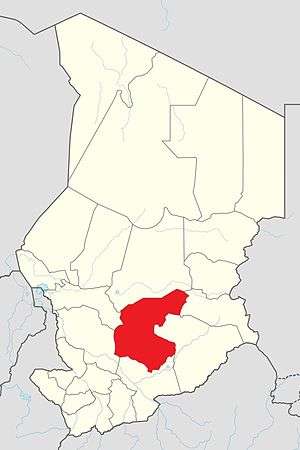Guéra (region)
Guéra (Arabic: قيرا) is one of the 23 regions of Chad, created in 2002 from the former Guéra prefecture. [1] The region's capital is Mongo. As of 2009, the population of the region was 553,795.
Guéra قيرا | |
|---|---|
 Map of Chad showing Guéra. | |
| Country | Chad |
| Departments | 4 |
| Sub-prefectures | 12 |
| Regional capital | Mongo |
| Government | |
| • Governor | Koldimadji Mirari (2008) |
| Population (2009) | |
| • Total | 553,795 |
Geography
The region borders Batha Region to the north, Sila Region and Salamat Region to the east, Moyen-Chari Region to the south, and Chari-Baguirmi Region and Hadjer-Lamis Region to the west. The region contains several mountainous areas, such as the Kadam Massif and the Guéra Massif, the latter of which is composed of granites dissected by numerous dolerite dykes.[2]
The Guéra Region receives an annual rainfall of 744 mm (29.3 in). The region is the principal agricultural producing area in the whole country, producing cotton and groundnuts, the two main cash-crops of the country, as well as rice.[3]
Half of the Zakouma National Park lies within the region.[4]
Subdivisions
Departments
The region of Guéra is divided into four departments, namely:
Sub-prefectures
Mongo is the regional capital. Sub-prefectures are:[5]
Administration
As a part of decentralization in February 2003, the country is administratively split into regions, departments, municipalities and rural communities. The prefectures which were originally 14 in number were re-designated in 17 regions. The regions are administered by Governors appointed by the President. The Prefects, who originally held the responsibility of the 14 prefects, still retained the titles and were responsible for the administration of smaller departments in each region. The members of local assemblies are elected every six years, while the executive organs are elected every three years.[6]
Demographics
As per the census of 2009, the population of the region was 553,795, 51.8 per cent female. The average size of a household as of 2009 was 5.2 people: 5.2 in rural households and 5.3 in urban areas. The number of households was 106,348: 91,557 in rural areas and 14,791 in urban areas. The number of nomads in the region was 15,417 (4 per cent of the population). There were 552,378 people residing in private households. There were 239,451 above 18 years of age: 107,285 male and 132,166 female. The sex ratio was 93 females for every hundred males. There were 538,378 sedentary staff, comprising 5 per cent of the population.[7]
As of 2016, the population of Guéra region was 564,910. There were 1,116 villages in 2016.[8]
Ethnic groups
The main ethnolinguistic groups are broadly split into Arabs groups such as the Baggara, generally speaking Chadian Arabic (21.11%), and a diverse group of peoples collectively termed the Hadjarai (66.18%).[7]
Hadjarai is an Arabic term and comprises numerous separate groups within Guéra. These Hadjerai ethnic groups speak a variety of East Chadic B languages, Bagirmi languages, and Bua languages, including:[9]
Other groups in the region include:[10]
References
- "Ordonnance n° 002/PR/08 portant restructuration de certaines collectivités territoriales décentralisées" [Ordinance No. 002/PR/08 on restructuring of certain decentralized local authorities]. Government of Chad. 19 February 2008. Archived from the original on March 4, 2016.
- Nkouandou, Oumarou Faarouk; et al. (2017-05-22). "The dolerite dyke swarm of Mongo, Guéra Massif (Chad, Central Africa): Geological setting, petrography and geochemistry". Open Geosciences. 9 (1): 138–150. doi:10.1515/geo-2017-0012. ISSN 2391-5447.
- Hilling, David (2004). "Chad - Physical and Social Geography". Africa South of the Sahara 2004. Psychology Press. p. 218. ISBN 9781857431834.
- "Chad - Salamat Province - Basemap (26-Oct-17)" (PDF). Médecins Sans Frontières. Retrieved 28 September 2019.
- "Tchad : Région du Sila - Juin 2010" (PDF). UNOCHA. Retrieved 27 September 2019.
- Republic of Chad Public Administration and Country profile (PDF) (Report). Department of Economic and Social Affairs (DESA), United Nations. 2004. p. 9. Retrieved 17 November 2016.
- "Census of Chad". National Institute of Statistical, Economic and Demographic Studies, Chad. 2009. Archived from the original on 21 November 2016. Retrieved 17 November 2016.
- Oxfam and Office National de Développement Rural (ONDR). 2016. Atlas de la vulnérabilité dans le Guera. Première partie: synthèse regional. 2nd edition (updated from 2013 edition). PASISAT (Projet d’Appui à l’Amélioration du Système d’Information sur la Sécurité Alimentaire au Tchad).
- Chesley, William T. (May 1994). "Une enquete sociolinguistique parmi les sokoro du Guera" (PDF). Société Internationale du Linguistique (in French). Archived from the original (PDF) on 2007-09-27.
- "Languages of Chad". Ethnologue. Retrieved 27 September 2019.